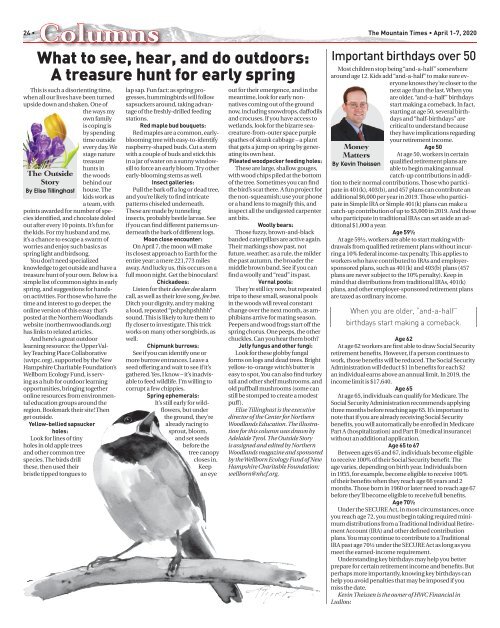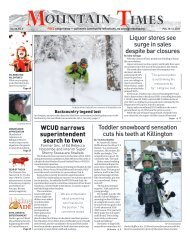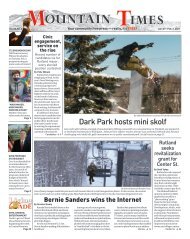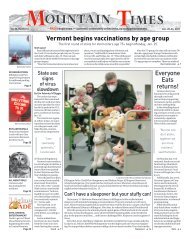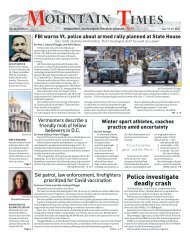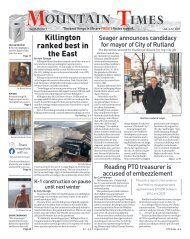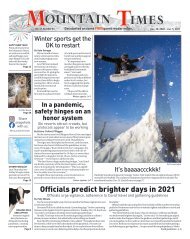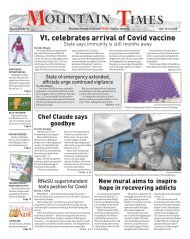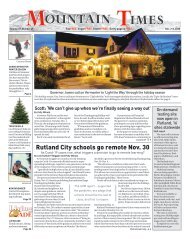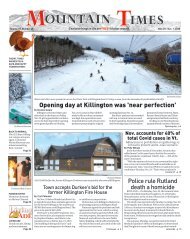Mountain Times - Volume 49, Number 14: April 1-7, 2020
Create successful ePaper yourself
Turn your PDF publications into a flip-book with our unique Google optimized e-Paper software.
Columns<br />
24 • The <strong>Mountain</strong> <strong>Times</strong> • <strong>April</strong> 1-7, <strong>2020</strong><br />
What to see, hear, and do outdoors:<br />
A treasure hunt for early spring<br />
This is such a disorienting time,<br />
when all our lives have been turned<br />
upside down and shaken. One of<br />
the ways my<br />
own family<br />
is coping is<br />
by spending<br />
time outside<br />
every day. We<br />
stage nature<br />
treasure<br />
The Outside<br />
Story<br />
By Elise Tillinghast<br />
hunts in<br />
the woods<br />
behind our<br />
house. The<br />
kids work as<br />
a team, with<br />
points awarded for number of species<br />
identified, and chocolate doled<br />
out after every 10 points. It’s fun for<br />
the kids. For my husband and me,<br />
it’s a chance to escape a swarm of<br />
worries and enjoy such basics as<br />
spring light and birdsong.<br />
You don’t need specialized<br />
knowledge to get outside and have a<br />
treasure hunt of your own. Below is a<br />
simple list of common sights in early<br />
spring, and suggestions for handson<br />
activities. For those who have the<br />
time and interest to go deeper, the<br />
online version of this essay that’s<br />
posted at the Northern Woodlands<br />
website (northernwoodlands.org)<br />
has links to related articles.<br />
And here’s a great outdoor<br />
learning resource: the Upper Valley<br />
Teaching Place Collaborative<br />
(uvtpc.org), supported by the New<br />
Hampshire Charitable Foundation’s<br />
Wellborn Ecology Fund, is serving<br />
as a hub for outdoor learning<br />
opportunities, bringing together<br />
online resources from environmental<br />
education groups around the<br />
region. Bookmark their site! Then<br />
get outside.<br />
Yellow-bellied sapsucker<br />
holes:<br />
Look for lines of tiny<br />
holes in old apple trees<br />
and other common tree<br />
species. The birds drill<br />
these, then used their<br />
bristle tipped tongues to<br />
lap sap. Fun fact: as spring progresses,<br />
hummingbirds will follow<br />
sapsuckers around, taking advantage<br />
of the freshly-drilled feeding<br />
stations.<br />
Red maple bud bouquets:<br />
Red maples are a common, earlyblooming<br />
tree with easy-to-identify<br />
raspberry-shaped buds. Cut a stem<br />
with a couple of buds and stick this<br />
in a jar of water on a sunny windowsill<br />
to force an early bloom. Try other<br />
early-blooming stems as well.<br />
Insect galleries:<br />
Pull the bark off a log or dead tree,<br />
and you’re likely to find intricate<br />
patterns chiseled underneath.<br />
These are made by tunneling<br />
insects, probably beetle larvae. See<br />
if you can find different patterns underneath<br />
the bark of different logs.<br />
Moon close encounter:<br />
On <strong>April</strong> 7, the moon will make<br />
its closest approach to Earth for the<br />
entire year: a mere 221,773 miles<br />
away. And lucky us, this occurs on a<br />
full moon night. Get the binoculars!<br />
Chickadees:<br />
Listen for their dee dee dee alarm<br />
call, as well as their love song, fee bee.<br />
Ditch your dignity, and try making<br />
a loud, repeated “pshpshpshhhh”<br />
sound. This is likely to lure them to<br />
fly closer to investigate. This trick<br />
works on many other songbirds, as<br />
well.<br />
Chipmunk burrows:<br />
See if you can identify one or<br />
more burrow entrances. Leave a<br />
seed offering and wait to see if it’s<br />
gathered. Yes, I know – it’s inadvisable<br />
to feed wildlife. I’m willing to<br />
corrupt a few chippies.<br />
Spring ephemerals:<br />
It’s still early for wildflowers,<br />
but under<br />
the ground, they’re<br />
already racing to<br />
sprout, bloom,<br />
and set seeds<br />
before the<br />
tree canopy<br />
closes in.<br />
Keep<br />
an eye<br />
out for their emergence, and in the<br />
meantime, look for early nonnatives<br />
coming out of the ground<br />
now, including snowdrops, daffodils<br />
and crocuses. If you have access to<br />
wetlands, look for the bizarre seacreature-from-outer<br />
space purple<br />
spathes of skunk cabbage – a plant<br />
that gets a jump on spring by generating<br />
its own heat.<br />
Pileated woodpecker feeding holes:<br />
These are large, shallow gouges,<br />
with wood chips piled at the bottom<br />
of the tree. Sometimes you can find<br />
the bird’s scat there. A fun project for<br />
the non-squeamish: use your phone<br />
or a hand lens to magnify this, and<br />
inspect all the undigested carpenter<br />
ant bits.<br />
Woolly bears:<br />
Those fuzzy, brown-and-black<br />
banded caterpillars are active again.<br />
Their markings show past, not<br />
future, weather; as a rule, the milder<br />
the past autumn, the broader the<br />
middle brown band. See if you can<br />
find a woolly and “read” its past.<br />
Vernal pools:<br />
They’re still icy now, but repeated<br />
trips to these small, seasonal pools<br />
in the woods will reveal constant<br />
change over the next month, as amphibians<br />
arrive for mating season.<br />
Peepers and wood frogs start off the<br />
spring chorus. One peeps, the other<br />
chuckles. Can you hear them both?<br />
Jelly fungus and other fungi:<br />
Look for these globby fungal<br />
forms on logs and dead trees. Bright<br />
yellow-to-orange witch’s butter is<br />
easy to spot. You can also find turkey<br />
tail and other shelf mushrooms, and<br />
old puffball mushrooms (some can<br />
still be stomped to create a modest<br />
puff).<br />
Elise Tillinghast is the executive<br />
director of the Center for Northern<br />
Woodlands Education. The illustration<br />
for this column was drawn by<br />
Adelaide Tyrol. The Outside Story<br />
is assigned and edited by Northern<br />
Woodlands magazine and sponsored<br />
by the Wellborn Ecology Fund of New<br />
Hampshire Charitable Foundation:<br />
wellborn@nhcf.org.<br />
Important birthdays over 50<br />
Most children stop being “and-a-half” somewhere<br />
around age 12. Kids add “and-a-half“ to make sure everyone<br />
knows they’re closer to the<br />
next age than the last. When you<br />
are older, “and-a-half” birthdays<br />
start making a comeback. In fact,<br />
starting at age 50, several birthdays<br />
and “half-birthdays” are<br />
critical to understand because<br />
they have implications regarding<br />
Money<br />
Matters<br />
By Kevin Theissen<br />
your retirement income.<br />
Age 50<br />
At age 50, workers in certain<br />
qualified retirement plans are<br />
able to begin making annual<br />
catch-up contributions in addition<br />
to their normal contributions. Those who participate<br />
in 401(k), 403(b), and 457 plans can contribute an<br />
additional $6,000 per year in 2019. Those who participate<br />
in Simple IRA or Simple 401(k) plans can make a<br />
catch-up contribution of up to $3,000 in 2019. And those<br />
who participate in traditional IRAs can set aside an additional<br />
$1,000 a year.<br />
Age 59½<br />
At age 59½, workers are able to start making withdrawals<br />
from qualified retirement plans without incurring<br />
a 10% federal income-tax penalty. This applies to<br />
workers who have contributed to IRAs and employersponsored<br />
plans, such as 401(k) and 403(b) plans (457<br />
plans are never subject to the 10% penalty). Keep in<br />
mind that distributions from traditional IRAs, 401(k)<br />
plans, and other employer-sponsored retirement plans<br />
are taxed as ordinary income.<br />
When you are older, “and-a-half”<br />
birthdays start making a comeback.<br />
Age 62<br />
At age 62 workers are first able to draw Social Security<br />
retirement benefits. However, if a person continues to<br />
work, those benefits will be reduced. The Social Security<br />
Administration will deduct $1 in benefits for each $2<br />
an individual earns above an annual limit. In 2019, the<br />
income limit is $17,640.<br />
Age 65<br />
At age 65, individuals can qualify for Medicare. The<br />
Social Security Administration recommends applying<br />
three months before reaching age 65. It’s important to<br />
note that if you are already receiving Social Security<br />
benefits, you will automatically be enrolled in Medicare<br />
Part A (hospitalization) and Part B (medical insurance)<br />
without an additional application.<br />
Age 65 to 67<br />
Between ages 65 and 67, individuals become eligible<br />
to receive 100% of their Social Security benefit. The<br />
age varies, depending on birth year. Individuals born<br />
in 1955, for example, become eligible to receive 100%<br />
of their benefits when they reach age 66 years and 2<br />
months. Those born in 1960 or later need to reach age 67<br />
before they’ll become eligible to receive full benefits.<br />
Age 70½<br />
Under the SECURE Act, in most circumstances, once<br />
you reach age 72, you must begin taking required minimum<br />
distributions from a Traditional Individual Retirement<br />
Account (IRA) and other defined contribution<br />
plans. You may continue to contribute to a Traditional<br />
IRA past age 70½ under the SECURE Act as long as you<br />
meet the earned-income requirement.<br />
Understanding key birthdays may help you better<br />
prepare for certain retirement income and benefits. But<br />
perhaps more importantly, knowing key birthdays can<br />
help you avoid penalties that may be imposed if you<br />
miss the date.<br />
Kevin Theissen is the owner of HWC Financial in<br />
Ludlow.


